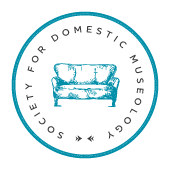Sara Klar is a multi-media artist based in Bed-Stuy, New York, whose work occupies the space between formal abstraction and the conceptual. When we first discussed the possibility of collaborating on a Domestic Museology exhibition, I visited her home and studio where it became immediately apparent that the scale and sheer volume of her work wouldn’t be well represented under the low ceilings of our apartment. Because of that—and the fact that she had set up her labyrinthine home/studio/gallery as the apotheosis of Domestic Museology—we agreed it would be best to bring a group to her. And so we did, on a mild Sunday afternoon in November.
Sara was born into a Fundamentalist Orthodox Jewish family and grew up in Far Rockaway, Queens, insulated from the secular world. She left her community of origin in her early 20s to pursue a life in art and much of her work grapples with issues around identity and received systems of belief. While she has painted for more than two decades, it is only recently that her work has overtly focused on her relationship to the Judaism of her upbringing. Through her massive collage paintings, drawing practice, photography, and sculptural work, she simultaneously explores the universal language of abstraction alongside a more personal and existential inquiry into the formation of identity both within a community and in opposition to it.
Sara’s massive canvases are a collage of paint, paper, and objects. To build up these densely layered works, she paints multiple paintings, one on top of the next, and then works back into the canvas using a knife to cut away some of the layers, excavating the painting’s own history. She also adds other materials, often Jewish ritual objects, such as a piece of tefillin (a small leather box containing Hebrew text and worn by men during prayer) or fragments from the Talmud, sometimes so obscured by the paint itself that they become almost unrecognizable. In these works, the process is performative and labor-intensive, often taking years with the finished canvas a chronicle of the many layers and paintings that have existed before the piece is done. In her words, “the present, in its immediacy is formed by the shadowed past”.
In another series, Sara takes her daily drawing and writing practice and makes it the subject of her photography, giving her personal and ephemeral sketches a heightened sense of narrative meaning. In this and in other bodies of her work, Sara uses mark-making as a way of mapping the evolution of self-hood. Asking the perennial, existential question: When is the moment when we elect to live by our own authority? How do we know who we truly are? While the vocabulary of her work is deeply personal, the throughlines of identity, feminism, and agency connect her work to a larger, communal conversation.
Sara Klar. Swimming to Enlightenment, 2019.
In the past few years, Sara has been working with Footsteps, an organization that supports people who chose to leave their Ultra-Orthodox communities by providing educational, vocational, and social support in the wake of what is often a wrenching personal choice. Some people come to Footsteps in possession of symbolic and ritual objects that relate to their former life: a wedding band or a shtreimel (the fur hats worn by some Haredi men), items that they can neither keep nor bring themselves to discard. Sara takes these charged objects and integrates them into her work as a way of transmuting their power and connecting her personal quest to a larger community.
Sara led nearly 14 guests through her apartment and studio, with works in every room (including the hallway!). The conversation was wide-ranging, from her delight in color, the artists who inspire her and the often very intense themes in her work. A consummate hostess, Sara provided a beautiful spread of food and drink and guests stayed well into the evening talking about art and life. When we started the Society for Domestic Museology almost 6 years ago, my goal was to bring people together in conversation around art in a way that was both intimate and accessible and I’m grateful to have had the opportunity to do this in Sara’s inspiring home studio.






